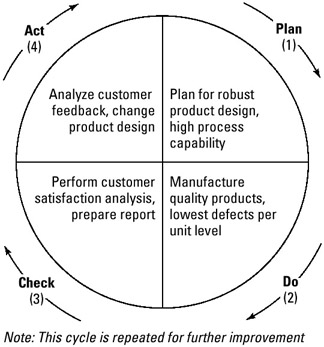Tool 180: Shewhart PDCA Cycle
| AKA | Plan-Do-Check-Act Strategy |
| Classification | Changing/Implementing (CI) |
Tool description
The Shewhart PDCA cycle is a structured cyclical approach for the continuous improvement of processes, products, or services. The plan-do-check-act cycle is usually tried first on a limited basis to test and validate the benefits of change prior to a full-scale implementation effort.
Typical application
-
To provide a set of guidelines for a systemic application of problem solving steps, for validation of quality improvement opportunities, or for the verification of design criteria in new product development.
-
To test an improvement idea for possible large-scale implementation.
-
To continuously improve the quality of processes, products, and services.
-
To transition from an idea exploration stage to a trial pilot project.
Problem-solving phase
| Select and define problem or opportunity | |
| Identify and analyze causes or potential change | |
| → | Develop and plan possible solutions or change |
| → | Implement and evaluate solution or change |
| → | Measure and report solution or change results |
| Recognize and reward team efforts |
Typically used by
| Research/statistics | |
| Creativity/innovation | |
| Engineering | |
| 2 | Project management |
| 4 | Manufacturing |
| Marketing/sales | |
| Administration/documentation | |
| 3 | Servicing/support |
| Customer/quality metrics | |
| 1 | Change management |
before
-
Variance Analysis
-
Systems Analysis Diagram
-
Gap Analysis
-
Force Field Analysis (FFA)
-
Process Mapping
after
-
Project Planning Log
-
Objectives Matrix (OMAX)
-
Work Flow Analysis (WFA)
-
Barriers-and-Aids Analysis
-
Action Plan
Notes and key points
-
Cross-reference to teh Deming PDSA cycle (tool 62) for a variation of this process.
Step-by-step procedure
-
STEP 1 Plan (P) a product, service, problem solution, or process improvement. See example From Product Development to Customer Satisfaction.
-
STEP 2 Do (D) the activity planned, conduct an experiment, or pilot the change.
-
STEP 3 Check (C) the results or effects of change. Analyze the collected data.
-
STEP 4 Act (A) on lessons learned. Mark decision on large-scale production or implementation, abandonment, or activity, or the repeating of cycle steps 1–4 for continued improvement.
Example of tool application
From Product Development to Customer Satisfaction

EAN: 2147483647
Pages: 326